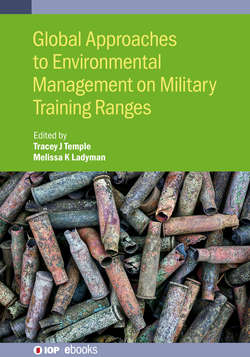Читать книгу Global Approaches to Environmental Management on Military Training Ranges - Tracey Temple - Страница 14
На сайте Литреса книга снята с продажи.
1.2 Contextualising military training environments
ОглавлениеFor security and safety reasons military training ranges are usually located in remote open spaces. This means they are often situated in sensitive or protected areas, which require careful management to ensure that military training can co-exist with the natural environment. In some countries due to space limitations military ranges may allow recreational access to the public, be used for farmland, or be situated near to residential areas.
Regular activities undertaken on training ranges may include transporting munitions around the site, live-fire training, tank manoeuvres, demolitions and open-burning of unused and out-of-date ordnance. In addition, abnormal activities may also occur such as blow-in-place of unexploded ordnance (UXO). As described in this chapter, historic explosive activities can have significant impacts on the environment such as contamination of soil and groundwater leading to ecological toxicity.
In order to manage and mitigate the environmental impact of explosive related activities on military training ranges it is necessary to understand how contaminants travel through the environment. Awareness of the fundamental principles that govern the behaviour of explosives in the environment allows their effects to be described and estimated for particular environments. For example, how explosives, combustion products and metals can be transferred from the point of use or disposal, to flora, fauna and ecosystems that may be adversely affected.
The transport pathways of contaminants can be conceptualised using the source-pathway-receptor (SPR) pollution linkages model [4]. The SPR model describes how a contaminant can enter the environment from a source such as, for example, deposited explosive residue, and moves through the environment by air, soil or water (pathway) to a receptor. A receptor is defined as an entity that may be adversely affected by interaction with a contaminant. An ‘entity’ can include flora and fauna, humans, the ecology of an area such as lake ecosystems and man-made structures and dwellings.
The point at which a contaminant reaches and affects a receptor is when the contaminant can be said to cause an environmental impact. If the SPR linkages between the source and receptor are broken at any point, i.e. if the contaminant does not reach a receptor, then no environmental impact will be observed. SPR conceptual diagrams can therefore be used to illustrate the pathways between sources and potential receptors in and around training ranges to predict possible environmental impacts.
Figures 1.1–1.3 outline basic SPR linkages for typical military training range activities that may lead to environmental impact. Simple diagrams can illustrate the main features of the training ranges such as basic topography, locations and depths of surface water, prevailing wind direction and nearby residential and recreational areas. Figure 1.1 illustrates the SPR linkage between live-fire training (source) and noise nuisance to local residents, structures and ecology (receptors). In this case, sound is transmitted through the air and ground (pathways) leading to noise nuisance and vibration that can cause damage to buildings and disrupt breeding and nesting habits for local fauna.
Figure 1.1. A conceptual diagram of the SPR linkages between the firing of guns and receptors.
Figure 1.2. SPR linkage between open-burning of explosives/munitions and receptors.
Figure 1.3. SPR linkages between buried UXO and receptors.
The SPR linkages for open-burning of munitions may include transmission through air (pathway) to cause local air pollution and nuisance from black smoke generation (source), as well as ground pollution from deposition of explosive, carbonised and heavy metal residues (sources) (figure 1.2).
The transport of explosive residue from a damaged UXO (source) through soil (pathway) to groundwater is shown in figure 1.3. Groundwater contamination may affect humans and animals (receptors) using the aquifer as a potable water source, or contaminate downstream rivers or lakes and affect local flora and fauna.
As shown by the examples above (figures 1.1–1.3), SPR conceptual diagrams can be very simple; however, they can be augmented with additional information depending on the circumstance. SPR diagrams should be developed before undertaking any practical work such as air, land and water sampling on the site to ensure a thorough understanding of the environment, or to highlight missing information about the site, e.g. the activities taking place. When undertaking an SPR evaluation the source is usually evident as it is directly related to activities on the range. Receptors can be identified through observation of the site, particularly where there have been historic contamination incidents. However, understanding the pathway is more complex as it depends on how the contaminant enters the environment and the physical and chemical interactions between the contaminant and the air, land or water. Understanding these pathways often requires a combination of real-world sampling, simulated experiments and predictive modelling.
